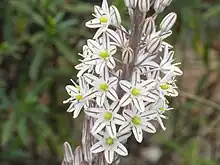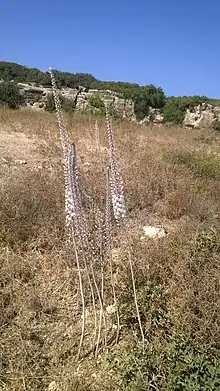Drimia
Drimia is a genus of flowering plants. In the APG IV classification system, it is placed in the family Asparagaceae, subfamily Scilloideae (formerly the family Hyacinthaceae[2]). When broadly circumscribed, the genus includes a number of other genera previously treated separately, including Litanthus, Rhodocodon, Schizobasis and Urginea.[1]
| Drimia | |
|---|---|
 | |
| Drimia maritima growing in the Sierra Madrona, Spain. | |
| Scientific classification | |
| Kingdom: | Plantae |
| Clade: | Tracheophytes |
| Clade: | Angiosperms |
| Clade: | Monocots |
| Order: | Asparagales |
| Family: | Asparagaceae |
| Subfamily: | Scilloideae |
| Genus: | Drimia Jacq. ex Willd.[1] |
| Synonyms[1] | |
| |

One of the best-known species is the sea squill, Drimia maritima (formerly Urginea maritima). Drimia intricata (formerly Schizobasis intricata) is sometimes cultivated as a bulbous or succulent plant.
Description
Drimia species are usually deciduous, more rarely evergreen, growing from bulbs. The bulbs may be underground or occur on or near the surface. Each bulb has one to several leaves that are often dry by the time the flowers open. The inflorescence is in the form of a raceme, with one to many flowers. At least the lower inflorescence bracts have spurs (a characteristic of the tribe Urgineeae). The individual flowers generally last for only one to two days and have white to yellowish green or brown tepals that are either free or joined into a basal tube. The tepals often have a darker central keel. After fertilization, an ovoid capsule forms with several seeds in each locule. The seeds are black and winged.[3]
Taxonomy
A formal description of genus Drimia first appeared in the fourth edition of Species Plantarum, published in 1799, authored by Carl Ludwig Willdenow. The name was attributed to Nikolaus Joseph von Jacquin.[1][4] When describing Drimia elata (the type species of the genus) in a work published in 1797, Jacquin said that he was unable to assign it to one of the known genera, and so constructed a new one. The name is erived from the Greek δριμεῖα drimeia, the feminine form of the adjective δριμύς drimys meaning "bitter" or "acrid", referring to the root.[5][6]
The boundaries between genera within the Scilloideae are not completely settled.[3][7] The situation has been described as being in a "state of flux".[2] As early as 1977, it was suggested that Urginea be merged into Drimia, although other small genera continued to be kept separate. In 2000, Peter Goldblatt and John Charles Manning proposed including other related genera, including Litanthus, Rhadamanthus and Schizobasis, a position supported later by some molecular phylogenetic studies.[3] This broad circumscription of Drimia is accepted by the World Checklist of Selected Plant Families.[1] Other sources prefer to maintain a larger number of segregate genera.[8][9] Regardless of whether a broad or strict view is taken of Drimia, it is placed in the tribe Urgineeae of the subfamily Scilloideae (or the subfamily Urgineoideae of the family Hyacinthaceae if this family is separated from Asparagaceae).[3]
Litanthus group
The genus Litanthus was for a long time monotypic, with the sole species L. pusillus, before in 2000 Goldblatt and Manning included it in Drimia.[3] A further species, Drimia stenocarpa, was added to the group in 2014. The Litanthus group is characterized by one- or occasionally two-flowered inflorescences with drooping tubular flowers whose tepals are united at the base for more than half their length.[10]
Rhodocodon group
The genus Rhodocodon was included in Drimia by Goldblatt and Manning in 2000.[3] The species of Rhodocodon, or the Rhodocodon group within Drimia, including D. cryptopoda, form a well supported clade endemic to Madagascar. They appear to be the product of a single invasion of Madagascar by an African species. A total of 13 species are recognized by those who separate the genus from Drimia.[8]
Schizobasis group
The genus Schizobasis was included in Drimia by Goldblatt and Manning in 2000.[3] As many as eight species have been described, but in 2014 these were reduced to two: Drimia intricata, including all the previously described species, and the new species Drimia sigmoidea. The Schizobasis group is distinguished by its well branched, thin-stemmed inflorescence and small, filiform leaves that are found only in seedlings, disappearing in mature plants.[11]
Species
As of August 2017, the World Checklist of Selected Plant Families accepted 100 species:[12]
- Drimia acarophylla E.Brink & A.P.Dold
- Drimia albiflora (B.Nord.) J.C.Manning & Goldblatt
- Drimia altissima (L.f.) Ker Gawl.
- Drimia anomala (Baker) Baker
- Drimia aphylla (Forssk.) J.C.Manning & Goldblatt
- Drimia arenicola (B.Nord.) J.C.Manning & Goldblatt
- Drimia aurantiaca (H.Lindb.) J.C.Manning & Goldblatt
- Drimia barkerae Oberm. ex J.C.Manning & Goldblatt
- Drimia basutica (E.Phillips) ined.
- Drimia brachystachys (Baker) Stedje
- Drimia calcarata (Baker) Stedje
- Drimia capensis (Burm.f.) Wijnands
- Drimia chalumnensis A.P.Dold & E.Brink
- Drimia ciliata (L.f.) J.C.Manning & Goldblatt
- Drimia cochlearis Mart.-Azorín
- Drimia congesta Bullock
- Drimia convallarioides (L.f.) J.C.Manning & Goldblatt
- Drimia cremnophila van Jaarsv.
- Drimia cryptopoda (Baker) Pfosser
- Drimia cyanelloides (Baker) J.C.Manning & Goldblatt
- Drimia delagoensis (Baker) Jessop
- Drimia dregei (Baker) J.C.Manning & Goldblatt
- Drimia duthieae (Adamson) Jessop
- Drimia echinostachya (Baker) Eggli & N.R.Crouch
- Drimia edwardsii N.R.Crouch & Mart.-Azorín
- Drimia elata Jacq.
- Drimia excelsa J.C.Manning & Goldblatt
- Drimia exigua Stedje
- Drimia exuviata (Jacq.) Jessop
- Drimia fasciata (B.Nord.) J.C.Manning & Goldblatt
- Drimia filifolia (Poir.) J.C.Manning & Goldblatt
- Drimia fimbrimarginata Snijman
- Drimia flagellaris T.J.Edwards
- Drimia fragrans (Jacq.) J.C.Manning & Goldblatt
- Drimia fugax (Moris) Stearn
- Drimia glaucescens (Engl. & K.Krause) H.Scholz
- Drimia guineensis (Speta) J.C.Manning & Goldblatt
- Drimia haworthioides Baker
- Drimia hesperantha J.C.Manning & Goldblatt
- Drimia hesperia (Webb & Berthel.) J.C.Manning & Goldblatt
- Drimia hockii De Wild.
- Drimia hyacinthoides Baker
- Drimia incerta A.Chev. ex Hutch.
- Drimia indica (Roxb.) Jessop
- Drimia intricata (Baker) J.C.Manning & Goldblatt
- Drimia involuta (J.C.Manning & Snijman) J.C.Manning & Goldblatt
- Drimia johnstonii (Baker) J.C.Manning & Goldblatt
- Drimia kniphofioides (Baker) J.C.Manning & Goldblatt
- Drimia laxiflora Baker
- Drimia ledermannii K.Krause
- Drimia ligulata J.C.Manning & Goldblatt
- Drimia loedolffiae van Jaarsv.
- Drimia macrantha (Baker) Baker
- Drimia macrocarpa Stedje
- Drimia macrocentra (Baker) Jessop
- Drimia marginata (Thunb.) Jessop
- Drimia maritima (L.) Stearn
- Drimia mascarenensis (Baker) J.C.Manning & Goldblatt
- Drimia maura (Maire) J.C.Manning & Goldblatt
- Drimia media Jacq. ex Willd.
- Drimia minuta Goldblatt & J.C.Manning
- Drimia multifolia (G.J.Lewis) Jessop
- Drimia multisetosa (Baker) Jessop
- Drimia mzimvubuensis van Jaarsv.
- Drimia nagarjunae (Hemadri & Swahari) Anand Kumar
- Drimia nana (Snijman) J.C.Manning & Goldblatt
- Drimia noctiflora (Batt. & Trab.) Stearn
- Drimia numidica (Jord. & Fourr.) J.C.Manning & Goldblatt
- Drimia occultans G.Will.
- Drimia oliverorum J.C.Manning
- Drimia ollivieri (Maire) Stearn
- Drimia pancration (Steinh.) J.C.Manning & Goldblatt
- Drimia polyantha (Blatt. & McCann) Stearn
- Drimia polyphylla (Hook.f.) Ansari & Sundararagh.
- Drimia porphyrantha (Bullock) Stedje
- Drimia psilostachya (Welw. ex Baker) J.C.Manning & Goldblatt
- Drimia pulchromarginata J.C.Manning & Goldblatt
- Drimia pusilla Jacq. ex Willd.
- Drimia razii Ansari
- Drimia rupicola (Trimen) Dassan. in M.D.Daddanayake & al. (eds.)
- Drimia salteri (Compton) J.C.Manning & Goldblatt
- Drimia sanguinea (Schinz) Jessop
- Drimia saniensis (Hilliard & B.L.Burtt) J.C.Manning & Goldblatt
- Drimia sclerophylla J.C.Manning & Goldblatt
- Drimia secunda (B.Nord.) J.C.Manning & Goldblatt
- Drimia senegalensis (Kunth) J.C.Manning & Goldblatt
- Drimia sigmoidea J.C.Manning & J.M.J.Deacon
- Drimia simensis (Hochst. ex A.Rich.) Stedje
- Drimia sphaerocephala Baker in W.H.Harvey & auct. suc. (eds.)
- Drimia stenocarpa J.C.Manning & J.M.J.Deacon
- Drimia sudanica Friis & Vollesen
- Drimia tazensis (Batt. & Maire) Stearn
- Drimia undata Stearn
- Drimia uniflora J.C.Manning & Goldblatt
- Drimia uranthera (R.A.Dyer) J.C.Manning & Goldblatt
- Drimia urgineoides (Baker) J.C.Manning & Goldblatt
- Drimia vermiformis J.C.Manning & Goldblatt
- Drimia virens (Schltr.) J.C.Manning & Goldblatt
- Drimia viridula (Baker) J.C.Manning & Goldblatt
- Drimia wightii Lakshmin.
In addition, 10 species described in 2015, and placed by the authors in Rhodocodon,[9] are, as of August 2017, treated as "unplaced" in the World Checklist of Selected Plant Families, which does not recognize the genus; none have names in Drimia:[13]
- Rhodocodon apiculatus H.Perrier ex Knirsch, Mart.-Azorín & Wetschnig
- Rhodocodon calcicola Knirsch, Mart.-Azorín & Wetschnig
- Rhodocodon campanulatus Knirsch, Mart.-Azorín & Wetschnig
- Rhodocodon cyathiformis H.Perrier ex Knirsch, Mart.-Azorín & Wetschnig
- Rhodocodon floribundus H.Perrier ex Knirsch, Mart.-Azorín & Wetschnig
- Rhodocodon graciliscapus Knirsch, Mart.-Azorín & Wetschnig
- Rhodocodon intermedius H.Perrier ex Knirsch, Mart.-Azorín & Wetschnig
- Rhodocodon linearifolius Knirsch, Mart.-Azorín & Wetschnig
- Rhodocodon monophyllus Knirsch, Mart.-Azorín & Wetschnig
- Rhodocodon rotundus H.Perrier ex Knirsch, Mart.-Azorín & Wetschnig
Distribution and habitat
The broadly defined genus has about 100 species found in Africa, including Madagascar, the Mediterranean area and Asia. About half of all the species occur in southern Africa, where species diversity is greatest in semi-arid regions with winter rainfall. Drimia generally is found in regions with seasonal dryness.[3]
References
- "Drimia Jacq. ex Willd.", World Checklist of Selected Plant Families, The Board of Trustees of the Royal Botanic Gardens, Kew, retrieved 2017-08-03
- Chase, M.W.; Reveal, J.L. & Fay, M.F. (2009), "A subfamilial classification for the expanded asparagalean families Amaryllidaceae, Asparagaceae and Xanthorrhoeaceae", Botanical Journal of the Linnean Society, 161 (2): 132–136, doi:10.1111/j.1095-8339.2009.00999.x
- Manning, J.C.; Goldblatt, P.; Fay, M.F. (2004). "A revised generic synopsis of Hyacintheaceae in sub-Saharan Africa, based on molecular evidence, including new combinations and the new tribe Pseudoprospereae". Edinburgh Journal of Botany. 60 (3): 533–568. doi:10.1017/S0960428603000404.
- Willdenow, C.L. (1799), "651 Drimia", Species Plantarum : Editio Quarta (in Latin), vol. 2, Berlin, pp. 165–166, retrieved 2017-08-03
- Jacquin, N.J. (1797) [title page 1796], "Drimia elata", Collectaneorum Supplementum (in Latin), Vienna (Vindobona), pp. 38–39, retrieved 2017-08-03
- δριμύς. Liddell, Henry George; Scott, Robert; A Greek–English Lexicon at the Perseus Project.
- Wetschnig, W.; Pfosser, M. (2003). "The Scilla plumbea puzzle – present status of the genus Scilla sensu lato in southern Africa and description of Spetaea lachenaliiflora, a new genus and species of Massonieae (Hyacinthaceae)". Taxon. 52 (1): 75–91. doi:10.2307/3647303. JSTOR 3647303.
- Pfosser, Martin; Knirsch, Walter; Pinter, Michael; Ali, Syed Shujait; Dutta, Suchandra & Wetschnig, Wolfgang (2012), "Phylogenetic relationships of Malagasy Hyacinthaceae", Plant Ecology and Evolution, 145 (1): 65–72, doi:10.5091/plecevo.2012.590
- Knirsch, Walter; Martínez Azorín, Mario; Pfosser, Martin & Wetschnig, Wolfgang (2015-01-23), "The reinstatement and rediagnosis of the madagascan genus Rhodocodon (Asparagaceae, Scilloideae), with validation and remarks on H. Perrier's taxa", Phytotaxa, 195 (2): 101–134, doi:10.11646/phytotaxa.195.2.1
- Manning, J.C.; Deacon, J. & Goldblatt, P. (2014), "A review of the Litanthus group of Drimia Jacq. (Hyacinthaceae: Urgineoideae) with the description of a second species, Drimia stenocarpa, from Western Cape", South African Journal of Botany, 90: 96–100, doi:10.1016/j.sajb.2013.10.006
- Manning, John; Deacon, James & Goldblatt, Peter (2014), "A review of the Schizobasis group of Drimia Jacq. (Hyacinthaceae: Urgineoideae), and the new species D. sigmoidea from Western Cape, South Africa", South African Journal of Botany, 94: 263–269, doi:10.1016/j.sajb.2014.07.011
- Search for "Drimia", World Checklist of Selected Plant Families, Royal Botanic Gardens, Kew, retrieved 2017-08-04
- "Search for Rhodocodon", World Checklist of Selected Plant Families, Royal Botanic Gardens, Kew, retrieved 2017-08-05
Bibliography
- Steinheil, Adolph (1834). "Matériaux pour servir a la flore de barbarie III: Note sur le genre Urginea nouvellement formé dans la famille Liliacées". Annales des sciences naturelles Botanique (in French). Second series 1: 321–332.